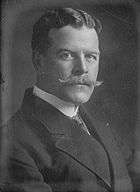Hamilton Wright

Hamilton Wright served as the United States Opium Commissioner
Biography
Early life
Hamilton Wright was born in Ohio in 1867. He graduated with first-class honors from McGill University in Montreal, in 1895. He served on the hospital at McGill for one year, then spent two years in China and Japan, studying scientific, social, and economic conditions. In 1897, he received the British Medical Association Studentship for research on the nervous system. In 1900-1903, he served upon a special mission in India, studying tropical diseases. He returned to the United States in 1903.
Career
He made his name by supposedly finding a pathogen that "caused" beri-beri (before it was discovered to be a vitamin deficiency).[1] He authored many articles and monographs on the nervous system, as well as on the social and economic problems in the tropics.
He was appointed by U.S. President Theodore Roosevelt as United States Opium Commissioner on July 1, 1908. In February 1909, he served as U.S. delegate to the International Opium Commission in Shanghai, China. He served at the follow-on conference at The Hague in 1911.
William Howard Taft saw that the U.S. could capitalize on the Chinese market if it would join forces with them in combating their opium problem. The problem was, the U.S. didn't have its own house in order. As a result, Wright became the first of many U.S. anti-drug crusaders.[2] "Of all the nations of the world, the United States consumes most habit-forming drugs per capita," Wright said in 1911, calling opium "the most pernicious drug known to humanity."[3]
His wife, Elizabeth Wright, was an assessor to the League of Nations Opium Advisory Committee in the 1920s, although the British Foreign Office called her "incompetent, prejudiced, ignorant, and so constituted temperamentally as to afford a ready means of mischief-making."[4]
References
- Primary sources
- 1. Marshall, Edward (March 12, 1911). ""UNCLE SAM IS THE WORST DRUG FIEND IN THE WORLD"; Dr. Hamilton Wright, Opium Commissioner, Says We Use More of That Drug Per Capita Than the Chinese.". The New York Times. Retrieved 2009-07-26.
READ this paragraph and gasp. "Of all the nations of the world," Dr. Hamilton Wright, who knows more of the subject than any other living man, told me the other day, "the United States consumes most habit-forming drugs per capita. Opium, the most pernicious drug known to humanity, is surrounded, in this country, with far fewer safeguards than any nation in all Europe fences it with.
- ↑ Hep-cats, Narcs, and Pipe-Dreams: A History of America's Romance with Illegal Drugs, by Jill Johnnes (1996).
- ↑ Hep-cats, Narcs, and Pipe-Dreams: A History of America's Romance with Illegal Drugs, by Jill Johnnes (1996).
- ↑ http://www.druglibrary.org/schaffer/History/e1910/worstfiend.htm, accessed 8/25/2011
- ↑ Minute by B.C. Newton, 5 March 1925, FO 371/10966, National Archives, Kew, UK